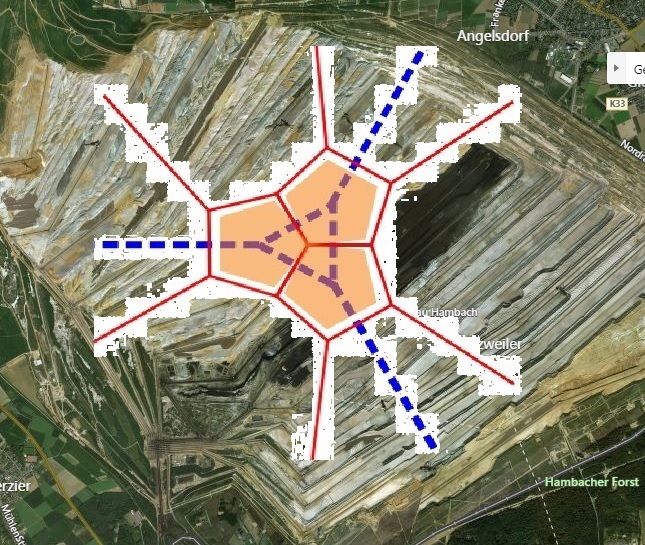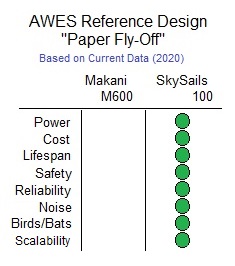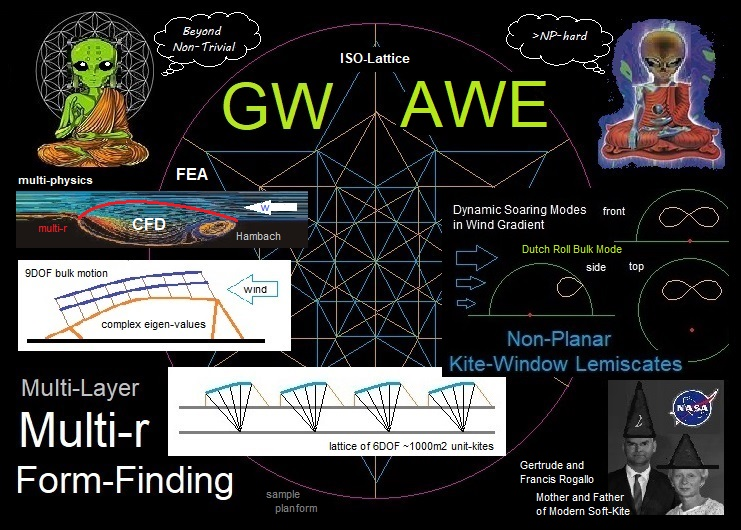Scaling
Matters
- Coteries,
trees, roots, trains, arch trains, unit scaling, farm scaling, tension
gathering, centralizing, lattices, networks, 3r, multi-r, fencing,
matrices, laddering, FFAWE atmospheric populating,
- LEI Scaling Law
- TW Scale AWE
- Scaling by Topologically Ordered Stability
- Rigid Wings versus Soft Wings for Generating Utility-Scale Kitricity
- Mega-scale Soft Kinetic-Kite AWES
- Scaling of Ram-Air Wings in Kite Systems
- Form Finding for AWE | What forms or topologies will GW AWES take?
- Mass Scaling Exponents topic
- Nets, Networks, and Network Dynamics topic
Send
AWE notes and topic replies to editor@upperwindpower.com
Nov. 21, 2020, post by Dave Santos
Curious voting for SaulG to be Biden's US DOE Secretary of Energy-
Curious voting for SaulG to be Biden's US DOE Secretary of Energy-
Meanwhile
the AWE R&D Community goes on without him. There is gradually
broader understanding about the scaling issues that doomed Makani's
architectural down-select. [Sommerfeld et al. 2020] is the latest such
handwriting on the wall. Here I extend that treatment to power-kite
derivatives, summarizing what has been long known.
Good
Luck to Saul, if gets another chance in AWE, to go back wiser to the
drawing board. The M600 averaged barely 5hrs before crashing and used
more power than it generated. For what it cost to validate that
predicted outcome, over 300 universities could have been funded at a
million apiece, under an Optimal Research Design paradigm, across the
entire Kite Energy concept space. DOE struggling to mobilize in AWE
from zero. ARPA-E, Zoi, and Felker went down the wrong alley. The SS
power kite has really blossomedmeanwhile. Even NPWs are considered hot
again. Scalable Kite Networks have a growing academic following.
The kite quest continues. Today's bit-
Biological and Aerospace Allometry (Scaling Law Science) for AWE
Aerospace Engineering Scaling Factors are essential to scaling up any design class. Too often engineering scaling limits were found by tragic failures, but sometimes luck allowed greater than imagined scaling. Jumbo jets scaled better than anyone foresaw because unit-human volume remained constant, as airframe volume grew cubically. On the other hand, Makani's M600 "Energy Drone" was a brittle feeble giant, because applicable engineering scaling limits, as Galileo laid out with animal bones, were disregarded.
Biological Allometry has half a billion years of lessons to teach Aerospace about mechanical scaling, especially AWES design. We know that Single-Skin (SS) tensile membranes scale the best, because they are quasi-2D structures. We have rough metrics for Fractal Dimensions and Scaling Exponents. Most AWES designers still struggle to compare the performance, safety, and LCOE of rigid wings that barely scale past 50m2 and crude SS ship-kites that can unit-scale to 1500m2 and beyond, then further scale in many-unit networks.
There is a lot more to discover about AWES scaling, and Biological Allometry has a lot of insight to offer. For example, bone-based endo-skeletons tend to scale better than exoskeletons or hydrostatic skeletons Accordingly, the scaling limits of LTA airships are fairly well established. However, the anchor field of a networked AWES uses the Earth itself as a "bone", and thus has no scaling limit short of planetary-scale itself. On the other hand, the hydrostatic vertical AWES scale limit becomes marginal past 10km (somewhere around 20km high). These are basic Allometric Laws for AWES.
Lets not forget Allometric Economies-of-Scale for Energy Grids, favoring very large unit-plants. Just as the Solar Cell is networked into a Solar Plant, the HAWT blade into a Wind Farm, so will the kite be networked to optimal unit-plant scale. Aerodynamic scaling invariance, due to constant wind unit-velocity, is our favor. Large bird formations fly farther, higher, and faster than a single bird can. Vast starling murmurations scale well, with amazing dynamics. Kite Networks have always scaled well in classic kiting, with many records beyond single-unit-scale, like kite-trains to 10km high a century ago. We are just now finally formalizing the Allometry of why this is so.
=> Allometry
=> Allometric engineering
Treatment of Ampyx-derived rigid-wing AWES scaling by [Sommerfeld, et al, 2020]: Ground-generation airborne wind energy design space exploration
Markus Sommerfeld 1, Martin Dörenkämper 2, Jochem De Schutter 3, and Curran Crawford 1
1 Institute for Integrated Energy Systems, University of Victoria, British Columbia, Canada
2 Fraunhofer Institute for Wind Energy Systems, Oldenburg, Germany
3 Systems Control and Optimization Laboratory IMTEK, Freiburg, Germany
"Metabolic supply‐demand balance" as an analog of SS Power Kite Load-path Scaling properties.
Network allometry
A. Maritan, R. Rigon, J. R. Banavar, A. Rinaldo
Tent Caterpillar webs are known to cover acres, as an Allometric suggestion of how much kite networks might scale from small units: IMAGEnotYetAvail
[Ed adding:
- SWNS image
- Other similar images
- Lateral .... [ ] Explore the click-through images ...
- https://studiotomassaraceno.org/hybrid-webs/
- https://studiotomassaraceno.org/how-to-catch-a-universe-in-a-spiderweb/
]
htttp://www.energykitesystems.net/AirborneWindEnergy/kPower/strip-mine.jpg

Adding Scalability to "Paper Fly-Off"
"Energy Drones" compete poorly with Power Kites in early AWE.
This was known aerospace reality in 2006, when Makani started.
AWEurope has a lot Energy Drone exposure. VTOL and Control
Pod dependence are seriously problematic as well.
Multi-kite Networks are the coming AWES reference architecture.
Megascalability...


Re: AWES Scaling-Limit Factors
Discussion of scaling laws :
Highest Power-to-Mass-
Mass is parasitic of Power available for heaver-than-air flight.
Free-Energy of an AWES is proportional to Power-to-Mass-over-Time and
Square-Cube scaling loss. The highest theoretic Power-to-Mass is pure
super-Polymer (ie. UHMWPE) kept at rated working load. AWES flygen
power electronics, avionics, actuators, composite resin filler, etc.,
are all parasitic of Power-to-Mass.
Many-Connected Topological-Order (Fractal Networks)- Unit-Kites
in lattices greatly enable AWES scaling. For example, a century ago
Kite Trains routinely reached ~10 km altitudes (limited by low air
density at Tropopause). The modern Single-Kite Altitude record is only
half as high, despite better materials and kite design. Many-connected
Topological Order also scales by Fault-Tolerance-
"Scale-free property strongly correlates with the network's robustness to failure. It turns out that the major hubs are closely followed by smaller ones. These smaller hubs, in turn, are followed by other nodes with an even smaller degree and so on. This hierarchy allows for a fault tolerant behavior." Wikipedia
Conclusion-
Scaling
Laws are a tremendously neglected topic in AWES R&D. Most early
AWES architectures cannot scale to Utility-Scale, by known aerospace
scaling factors. Single-line single unit-kite AWES topology,
parasitically burdened with non-polymer masses, is repeatedly proving
unscalable in testing, by public data metrics of multiple ventures.
AWES
many-connected topological order of pure polymer "wing and string" is
theoretically favored to scale best. Optimal research design based on
comparative testing will settle all doubts.
AWES Scaling-Limit Factors
AWES
Engineering Scaling Factors are closely interrelated, collectively
limiting the final achievable scale of an AWES design. AWES Unit-Plants
must safely and cost-effectively scale to multi-GW in order to
decisively offset fossil-fuels and nukes. Scaling potential is a
primary metric of AWES fitness to capture by a TPL Scoring Matrix.
Square-Cube Galilean Scaling Limit- As a bulk-material scales in 3D, material strength remains constant and does not keep up.Most-Probable Wind-Velocity Scaling-Limit- As a kite scales, minimum flight-velocity increases, but wind-velocity remains constant.Topological Fractal Scaling-Limit- As structural geometry scales, new fractal sub-dimensions of many-connected geometric structure are needed to extend scaling Square-cube limits. Jumbo jets are somewhat larger than simple scaling limits because unit-passenger remains at constant mass and scale.Thermal (Thermal-Electric) Scaling-Limit- As heat-engines scale, thermodynamic heating-cooling cycles slow down, as heat-transfer in solid materials remains at constant speed, must cover more distance. Larger fly-gen/E-VTOL (motor/gens) tend to overheat more because they cannot shed heat fast enough. More mass is required to maintain coolness, which causes square-cube mass-limits to dominate.Skin-Friction Scaling-Limit- Objects in dynamic contact become progressively vulnerable to surface-damage as they scale in mass. A soft kite is mostly limited in scale (<2000m2) by packed-state ground-handling stresses on constant panel-thickness of kite-fabric).Mass-Velocity Scaling-Limit (f=ma)- Combined high-mass and high-velocity is a primary aviation-safety metric, determining regulatory restrictions and insurability, with complex sub-factors.Dynamic Acceleration Scaling-Limit- Larger objects sooner experience excessively fast inertial rate changes, both translating and rotating.Tidal Scaling-Limit- Massive mechanisms that rotate on a horizontal axis, with respect to gravity, suffer increased tidal stress with size.Impact-Zone and Buffer-Zone Scaling-Limit- An AWES whose units can break-away and impact a wider area are far more scaling-limited than designs that never exceed their nominal footprint.Airspace Scaling-Limit- FAA currently limits AWES Research to a 2000ft Vertical ceiling, as a social scaling factor with physical foundations. The Atmosphere defines a Horizontal spatial limit.Airspace Specific-Power Scaling-Limit- AWES that fly tight patterns are most scalable by power-to-airspace. Note that lower specific-power-by-wing-area can beat higher specific-power-by-wing-area by flying a tight enough pattern.Tensile Loadpath Scaling-Limit- Single-Skin (SS) kites scale greatly, by quasi-2D geometry somewhat evading square-cube limit.Economic Scaling-Limit- Capital Cost limits how big a Plant can be affordably built. Paradoxically, a larger Plant may achieve greater economy-of-scale by lower LCOE.Acoustic Noise Scaling-Limit- Larger system-units can cause longer distance noise problems.Eyesore Scaling-Limit- Larger "eyesores" are more limited in public acceptability than a smaller eyesores. Exception Factors- Slower-moving, transparent and/or color-matched AWES.Imaginary Scaling-Limit- Some engineered systems could be designed larger (global quality-of-life minimums), but for a failure of imagination. Systems can grow beyond anyone's prior idea; or remain stuck small, from habit.Capacity Factor (Availability, Dispatchability) Scaling-Limit- Higher capacity systems need less installation space than equivalent density systems of less capacity.Limited Multi-use Scope Scaling (Land-Sea Co-use)- More versatile synergistic AWES designs with multiple high value functions and multi-use space, like agriculture, or even flight certification over populations, is more scalable.
----- new kPower slide ----kPower is working up a new AWE slide show for AWEC2020teleconference. Our old slide show was acclaimed the "best-ever presentation" at Austin HOG (House of Genius).A bit of AWE media fun for larger audiences, with lots of serious engineering elaborated in accompanying slides already shared and still pending-Click image for enlarged view: (image topic is not per se scaling topic but has some relation to scaling. Image is more related to the 3r topics.
